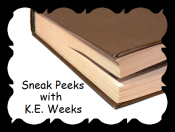 |
| This feature is presented by guest blogger, K.E.Weeks. |
My first thought, upon reading Revolver

The story is extremely suspenseful and well-crafted. However, it can be confusing to follow because chapters alternate between the present (1910) and the past (1899). After the initial few chapters, though, these flashbacks stop and the story continues in 1910. The description is extraordinary and reminiscent of Ernst Hemingway’s Iceberg Theory, in that more is concealed than revealed. For example, here is the author’s description of how a Colt pistol works:
“Well, when the hammer hits the percussion cap, the fulminate of mercury explodes, for it cannot tolerate being struck. You see? Once the cap explodes, it sets fire to the gunpowder inside the case, and instantly the temperature inside the case rises to a couple of thousand degrees, as hot as the smelting works at the mine, but all inside that tiny brass case.
Now, Sig, the brass case, being so hot, there and then expands, and swells to press against the inside of the chamber, and now it releases its grip on the lead bullet. This bullet is sitting at the front of the miniature fire in the case, with gases that expand and send it out of the chamber and off down the barrel. And this is the most remarkable thing of all. For the barrel down which the bullet must travel is, by a fraction, smaller than the bullet.”
“But you said everything was measured to perfection.”
“And so it is. Because inside that barrel is a series of three grooves, set out in a spiral down its length. The bullet, which is lead, and with the hellfire of that explosion behind it, is now both hot and soft. It’s forced into those spirals. They bite into it, so that as it makes its way down the barrel, it spins...” (Sedgwick 92 – 93).
Revolver is a great book for middle school and high school boys. It’s a relatively easy read with page-turning interest and so it might hold the attention of a reluctant reader, if he can keep track of the flashbacks. Violence is more implied—such as a puddle of blood— than described outright. There are no romantic scenes, but there is an innuendo of intended rape (to Sig’s sister Anna): “Oh, I’m not going to kill you. Not yet. I want something for my trouble” (Sedgwick 181).
The book also presents a few interesting questions for discussion, such as in this passage: “Does God turn his eyes away when bad things happen? Or does he watch, wondering at how his creation unfolds? Does he shake his head in sorrow? Or does he smile?” (Sedgwick 180). For the expert plotting and great twists, I give the story five stars (out of five).
In addition to being a psychological mystery, it is also a morality tale, as Sig wrestles with the lessons of his father, a practical and shrewd man, and those of his mother, a pious, God-fearing woman. Sig is forced to choose between faith and functionality. And, here is where the story is fabulous. It ends on Sig’s brilliant epiphany: “You know, I understand it now. There’s always a third choice in life. Even if you think you’re stuck between two impossible choices, there’s always a third way. You just have to look for it” (Sedgwick 199). Good advice, indeed.
Disclaimer: The purpose of this review is to guide parents into selecting appropriate, significant, high-quality literature for their teens and tweens. I have no connection with the author or publisher of this book. I am a home educator of two children, 12 and 14, with a Master of Art degree in American Literature and a keen interest in young adult fiction and nonfiction.
*Contains affiliate links
1 comment:
Hi K.E. :) You were right, this sounds like a book Matt will enjoy. Might be his first summer read. Sounds like one I'd like too.
Post a Comment